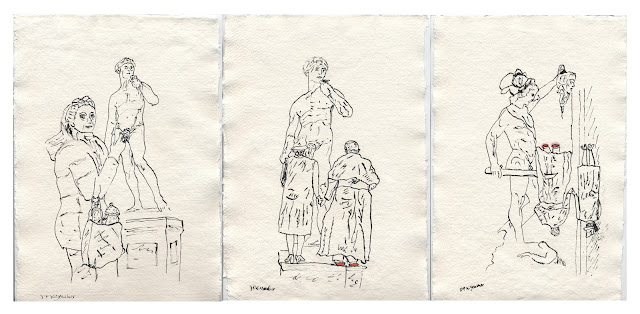During August it was a privilege to exhibit
for ten days at the Victoria Institute as a guest of Littlehampton Organisation
of Contemporary Arts, (LOCA) and the Arundel Gallery Trail. Both organisations
exist to help make art more accessible to a wider public audience and provide
opportunities for artists, from beginner to established, to show their work and
potentially make sales. Large numbers of visitors with varying degrees of
artistic appreciation walk the trail viewing art and craft in galleries and people’s
homes. The Arundel Gallery Trail is one of the most important events of its
type in the UK.
Interestingly it was also my first opportunity to personally discuss the aesthetic behind my body of work –Introibo ad altare Dei with a wide range of people, young, old, never previously thought about art through to artists, art teachers, higher education art mentors and lecturers. For me a fascinating and revealing experience.
Interestingly it was also my first opportunity to personally discuss the aesthetic behind my body of work –Introibo ad altare Dei with a wide range of people, young, old, never previously thought about art through to artists, art teachers, higher education art mentors and lecturers. For me a fascinating and revealing experience.
The most common question, occasionally
challenging being, what on earth is this body of work all about? And can you please
point to the metaphorical context so it can be understood? It was also strongly
apparent that the demands for explanation appeared directly relevant to the
artistic experience of the individual audience member with higher education
professionals in particular usually enquiring from a position of conceptual
empathy. But this experience did
encourage me to think hard, again, about whether or not the artist should
explain or document aesthetic motivation. Some of my most important mentors
have given totally opposing views, at one extreme it is wrong to explain and
the other no artist can be valid if their art is not fully documented.
So here is my proposed compromise solution.
The key to audience interpretation lies in my Amazon eBook paper (–Introibo ad altare Dei; Is artist intention
over-ruled by the unconscious self?) statement, “The concept remains in
place that audience members will draw different conclusions based on their
cultural perspective”. The main influencer for this is Umberto Eco , The
Poetics of the Open Work//1962 and his sentence, “Hence, every reception of a
work of art is both an interpretation
and a performance of it, because in
every reception the work takes on a fresh perspective for itself".
Controversially some view this as meaning the work of art actually changes as
each audience member engages with it.
However, responding to audience enquiries, it seems appropriate to provide some rationale to my thinking and a selection of clues to the multiple metaphors which have a role to play in the work and its interpretation. The figures are two dimensional drawings therefore they do not and can never exist in reality, referring to René Magritte. They are drawn from the visit of Pope Benedict XVI to the UK and Queen Elizabeth II. Considerations are my own Belfast Catholic cultural indoctrination, Hanoverian historical context, Church of England, London, Rome, Florence, sexual identity, marriage, Personal Ordinariates, male domination of religion, religious domination and abuse of our world, Carl Jung, the collective unconscious, quantum physics, time, dimensions and art. All underpinned with Aristotle’s Nicomachean Ethics and the title of the work appropriated from the first page of James Joyce’s Ulysses.
However, responding to audience enquiries, it seems appropriate to provide some rationale to my thinking and a selection of clues to the multiple metaphors which have a role to play in the work and its interpretation. The figures are two dimensional drawings therefore they do not and can never exist in reality, referring to René Magritte. They are drawn from the visit of Pope Benedict XVI to the UK and Queen Elizabeth II. Considerations are my own Belfast Catholic cultural indoctrination, Hanoverian historical context, Church of England, London, Rome, Florence, sexual identity, marriage, Personal Ordinariates, male domination of religion, religious domination and abuse of our world, Carl Jung, the collective unconscious, quantum physics, time, dimensions and art. All underpinned with Aristotle’s Nicomachean Ethics and the title of the work appropriated from the first page of James Joyce’s Ulysses.



No comments:
Post a Comment